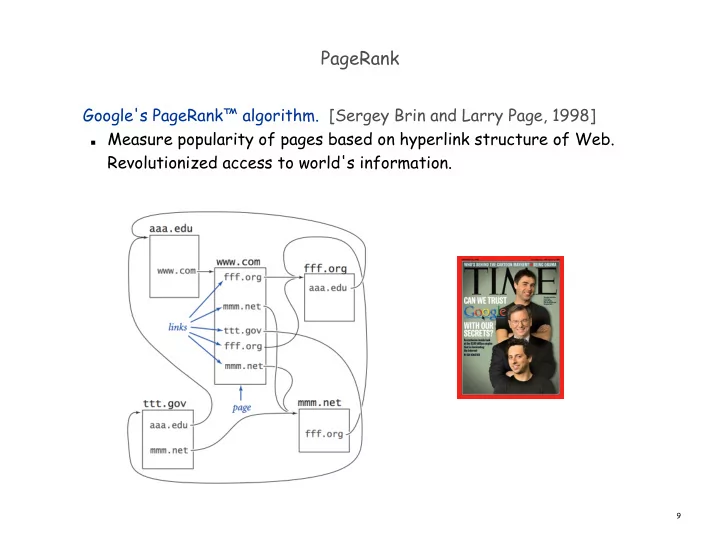

PageRank Google's PageRank™ algorithm. [Sergey Brin and Larry Page, 1998] Measure popularity of pages based on hyperlink structure of Web. Revolutionized access to world's information. 9
90-10 Rule Model. Web surfer chooses next page: 90% of the time surfer clicks random hyperlink. 10% of the time surfer types a random page. Caveat. Crude, but useful, web surfing model. No one chooses links with equal probability. No real potential to surf directly to each page on the web. The 90-10 breakdown is just a guess. It does not take the back button or bookmarks into account. We can only afford to work with a small sample of the web. … 10
Web Graph Input Format Input format. N pages numbered 0 through N-1. Represent each hyperlink with a pair of integers. 11
Transition Matrix Transition matrix. p[i][j] = prob. that surfer moves from page i to j . surfer on page 1 goes to page 2 next 38% of the time 12
Monte Carlo Simulation Monte Carlo simulation. How? see next slide Surfer starts on page 0 . Repeatedly choose next page, according to transition matrix. Calculate how often surfer visits each page. page transition matrix 16
Random Surfer Random move. Surfer is on page page . How to choose next page j ? Row page of transition matrix gives probabilities. Compute cumulative probabilities for row page . Generate random number r between 0.0 and 1.0 . Choose page j corresponding to interval where r lies. page transition matrix 17
Mathematical Context Convergence. For the random surfer model, the fraction of time the surfer spends on each page converges to a unique distribution, independent of the starting page. "page rank" "stationary distribution" of Markov chain "principal eigenvector" of transition matrix " 1,570,055 , 417,205 428,671 1,570,055 , 229,519 1,570,055 , 388,162 1,570,055 , 106,498 % $ ' # 1,570,055 & 20
The Power Method Q. If the surfer starts on page 0 , what is the probability that surfer ends up on page i after one step? A. First row of transition matrix. 22
The Power Method Q. If the surfer starts on page 0 , what is the probability that surfer ends up on page i after two steps? A. Matrix-vector multiplication. 23
The Power Method Power method. Repeat until page ranks converge. 24
26
Random Surfer: Scientific Challenges Google's PageRank™ algorithm. [Sergey Brin and Larry Page, 1998] Rank importance of pages based on hyperlink structure of web, using 90-10 rule. Revolutionized access to world's information. Scientific challenges. Cope with 4 billion-by-4 billion matrix! Need data structures to enable computation. Need linear algebra to fully understand computation. 27
Recommend
More recommend